MicroStrategy (MSTR): Why This Bitcoin Proxy Is Decoupling From BTC — And Is It Still a Buy?
TradingKey - MicroStrategy stock is in a sustained decline and remains entrenched in a downward channel, as Bitcoin continues to fall and briefly dipped below $100,000 on November 4, leading to a sharp decline in Bitcoin-related stocks. We believe MicroStrategy’s slump has not yet abated.
What Kind of Company is MicroStrategy?
MicroStrategy (stock ticker: MSTR), an American enterprise software company founded in 1989 and headquartered in Tysons Corner, Virginia, was formerly known as "MicroStrategy."
The company initially built its technological foundation on Business Intelligence (BI) and data analytics solutions, helping enterprises extract value from big data and optimize decision-making processes.
However, it was not its traditional business that propelled MicroStrategy into the global capital market spotlight, but rather the aggressive Bitcoin investment strategy spearheaded by founder Michael Saylor.
In August 2020, under the leadership of MicroStrategy Chairman Michael Saylor, the company began acquiring Bitcoin, becoming the first publicly traded company to implement a Bitcoin treasury strategy.
This shift transformed MicroStrategy's role on Wall Street from an "enterprise data service provider" into a "Bitcoin quasi-ETF proxy." Its stock price fluctuations now correlate highly with BTC, and investors' valuation judgments are predominantly tied to Bitcoin prices and market sentiment.
Why Did MicroStrategy Purchase Bitcoin?
I. Bitcoin as "Digital Gold"
Looking back to the initial outbreak of the COVID-19 pandemic in 2020, MicroStrategy was still rooted in its traditional business. To counter the crisis, the U.S. government continuously adjusted interest rates to 0%.
MicroStrategy faced a dilemma: on one hand, the company held a substantial amount of cash; on the other hand, the U.S. government's massive money printing and unprecedented monetary easing meant the company's cash couldn't even keep pace with inflation.
Given the low short-term returns on cash investments and the escalating risks of dollar depreciation and monetary expansion, Michael Saylor believedBitcoin resembled "digital gold" and was suitable as a tool to hedge against inflation and preserve value.
II. Providing a New Bitcoin Investment Channel
Due to regulatory reasons, many investors are unable to purchase Bitcoin directly on cryptocurrency exchanges and custody the asset themselves, or they fear exchange fraud. Consequently, investors sought safer investment avenues for crypto assets with less risk.
For investors, purchasingMicroStrategy stock not only offers an indirect way to invest in Bitcoin but also effectively mitigates risks associated with regulatory hurdles.
How Much Bitcoin Does MicroStrategy Hold?
As disclosed,MicroStrategy purchased an additional 397Bitcoins on November 3, 2025, for approximately $45.6 million, at an average price of about $114,771. As of 2025, the year-to-date return on Bitcoin has been 26.1%.
As of November 3, 2025,MicroStrategy held 641,205Bitcoins with a total value of approximately $47.486 billion, at an average cost of about $74,057 per Bitcoin.
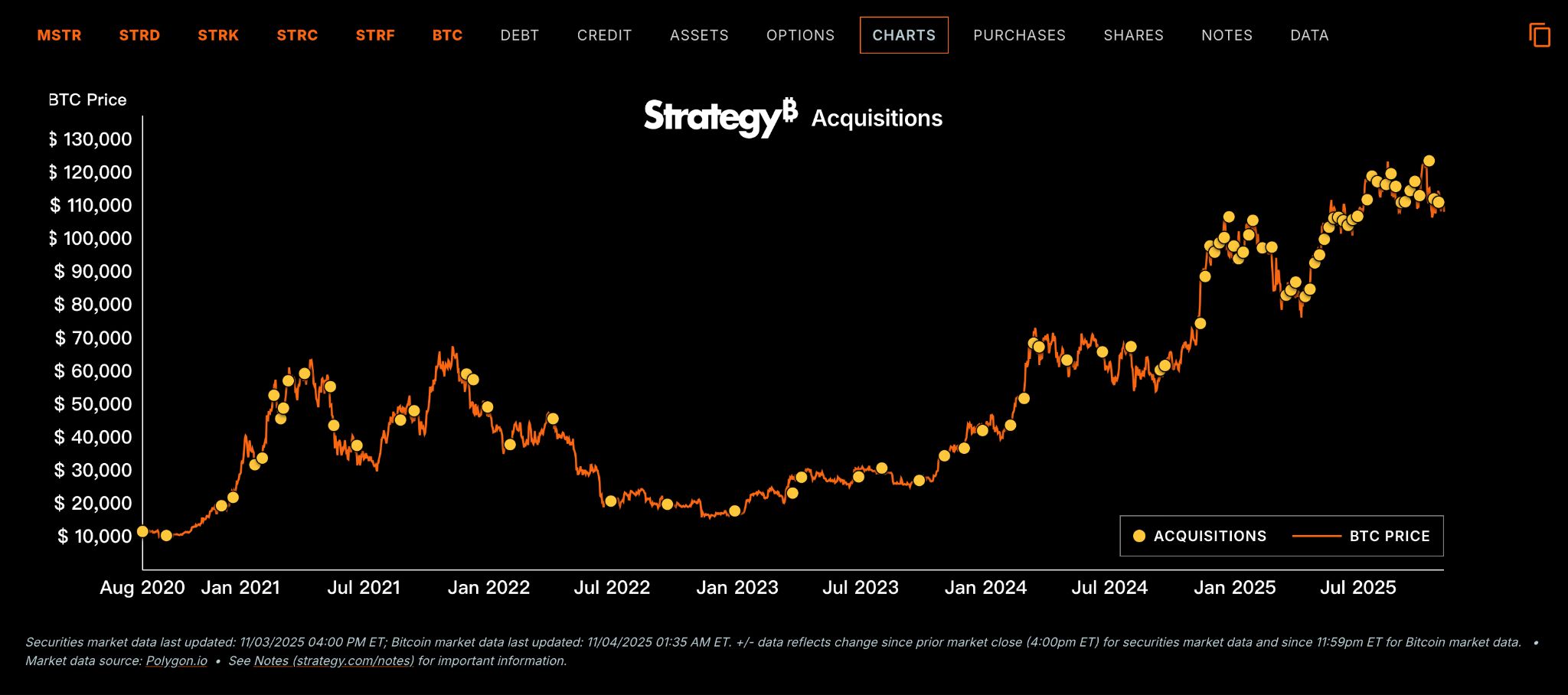
【MicroStrategy Increases Bitcoin Holdings, Source:www.strategy.com】
Currently, MicroStrategy remains the top corporate holder of Bitcoin, with a significant lead over other publicly listed companies. MicroStrategy’s market capitalization stands at $73.2 billion (as of November 6, EST), while its Bitcoin holdings alone are valued at an astonishing nearly $66 billion.

【Top 100 BTC Holdings, Source:bitcointreasuries.net】

【MicroStrategy Continues to Increase Bitcoin Holdings in Q4, Source:www.strategy.com】
Despite MicroStrategy's continued accumulation of Bitcoin, it is evident that the quantity of Bitcoin being purchased is trending downwards.
On one hand, Bitcoin’s price has experienced sustained high-frequency volatility, making it challenging to identify clear signals for further significant acquisitions. On the other hand, the company's current stock price and Bitcoin's price are struggling to move in synchronized correlation. This makes it difficult for MicroStrategy to continue driving its market capitalization higher through debt-fueled Bitcoin purchases. Instead, its net asset value premium (NVA) has been steadily declining. In other words, the premium associated with buying MicroStrategy stock is continuously diminishing.
What is MicroStrategy's Stock Price Trend?
Since MicroStrategy first publicly implemented its Bitcoin capital allocation strategy on August 10, 2020, its stock price has shown a strong positive correlation with Bitcoin's price.

【MicroStrategy/BTC Price Chart, Source: TradingView】
Over the past five years, every surge in Bitcoin has propelledMicroStrategy's stock price higher. In Q4 2024, MicroStrategy's stock soared, driven by market expectations that the company would be included in theNASDAQ-100 index.
On December 14, 2024, MicroStrategy was officially added to theNASDAQ-100 index. However, the market appeared to have fully digested this positive news, leading to a "buy the rumor, sell the fact" scenario. Coupled with Bitcoin's decline, MicroStrategy's stock was subsequently sold off by the market, falling over 50% from its peak, a much steeper drop than Bitcoin's decline during the same period.
In Q2 2025, Bitcoin gained market favor and entered a period of continuous rapid appreciation, as Trump's administration consistently affirmed its support for the cryptocurrency industry.MicroStrategy's stock price consequently benefited from this synchronicity.
However, over the past six months, we have observed thatMicroStrategy's stock price appears unable to consistently move in tandem with Bitcoin. Its year-to-date gains are significantly lower than Bitcoin's, and it exhibits a downward trend within a channel. Even as Bitcoin repeatedly reached new highs,MicroStrategy's stock price failed to replicate its ascent.
As Bitcoin's upward momentum weakens,MicroStrategy's stock price has even experienced a preemptive sell-off. After hitting a new high, the stock has plunged over 40%, virtually erasing all its year-to-date gains, experiencing an extreme rollercoaster ride during this period.
Could MicroStrategy Be Removed from the NASDAQ-100 Index?
After MicroStrategy was selected for theNASDAQ-100 index components last December, its stock briefly surged above $500. However, with the departure of speculative capital, even as BTC prices set new highs,MicroStrategy's stock price has not been able to reach new peaks.
From a structural perspective, the probability of MicroStrategy being delisted from theNASDAQ-100 index in the short term is almost zero.
According to the Nasdaq component adjustment rules, a company can only be removed under the following circumstances, unless it transforms into a financial institution, changes its listing venue, experiences a significant drop in liquidity, or violates listing regulations:
- Its market capitalization ranking falls outside the top 125;
- Its market capitalization ranking is below 100 for two consecutive quarterly reviews, and a suitable replacement company emerges;
- Or its weight in the index falls below 0.1% for two consecutive months, and a suitable replacement company emerges.
For more details, please refer to“Nasdaq-100 Index Methodology.”
In other words, MSTR's current market capitalization and trading activity are sufficient to ensure its position in the Nasdaq 100, meaning there is no short-term risk of delisting.
Is MicroStrategy Stock Still Worth Investing In?
Firstly, our view is thatMicroStrategy's stock price is currently still in a downward trend. If investors are looking for an entry point, a pullback to the key support level of 231.5 might present a short-term speculative opportunity.
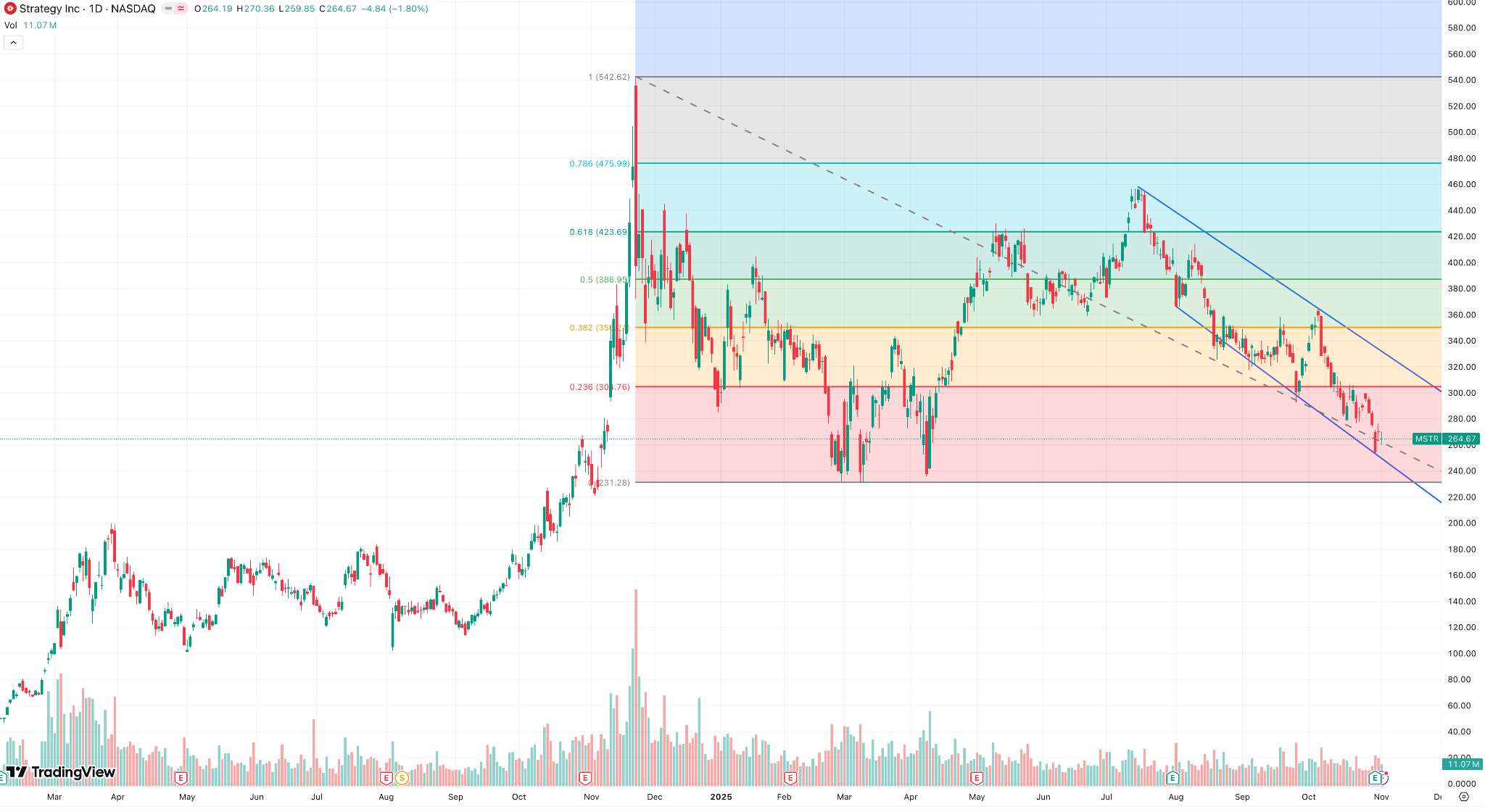
【MicroStrategy Stock Price Trend, Source: TradingView】
However, in the long run, MicroStrategy has not escaped its downtrend. Its future stock performance largely depends on market expectations for Bitcoin's future, and short-term technical support may not attract significant buying interest.
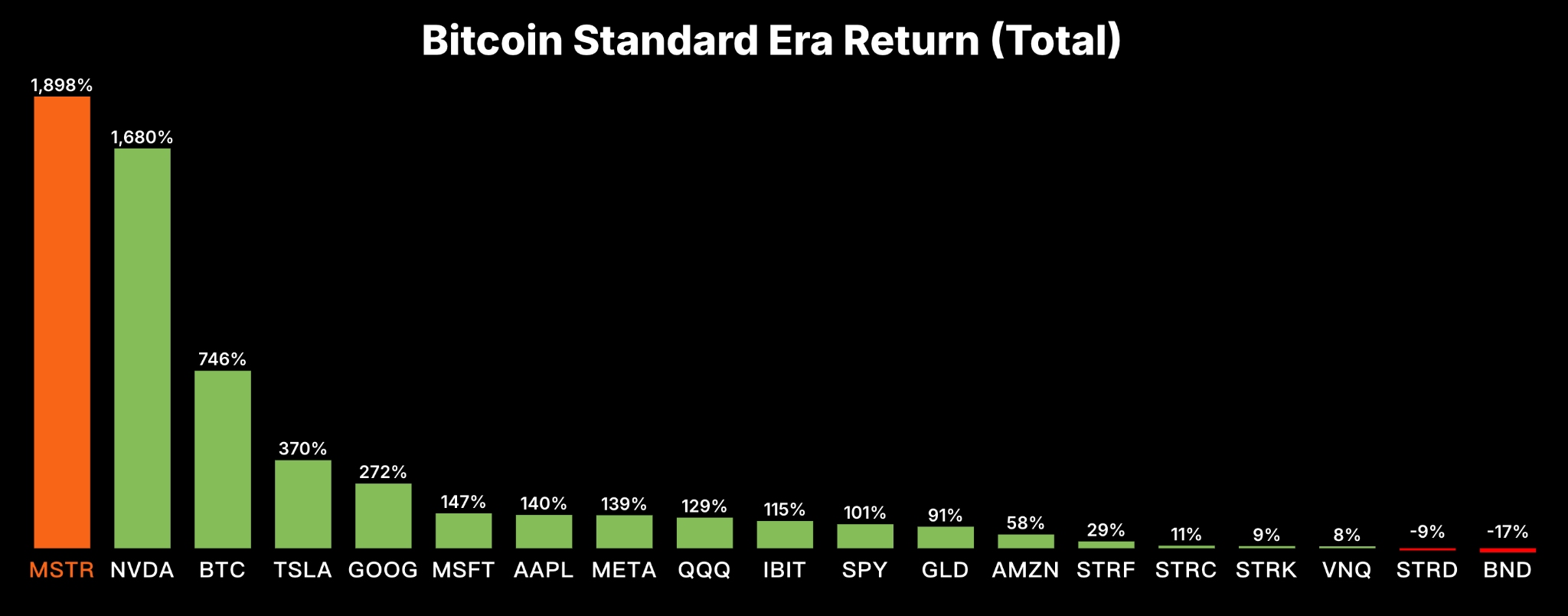
Even historically, when measured by Bitcoin's cycles,MicroStrategy's stock returns once surpassed those of many tech stocks – even Nvidia. However, such substantial returns inevitably come with significant pullback risks.
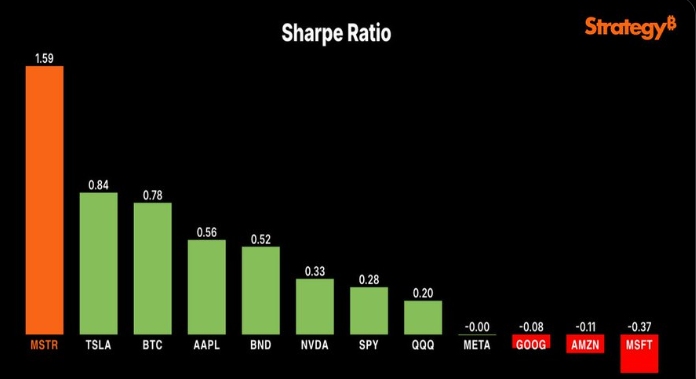
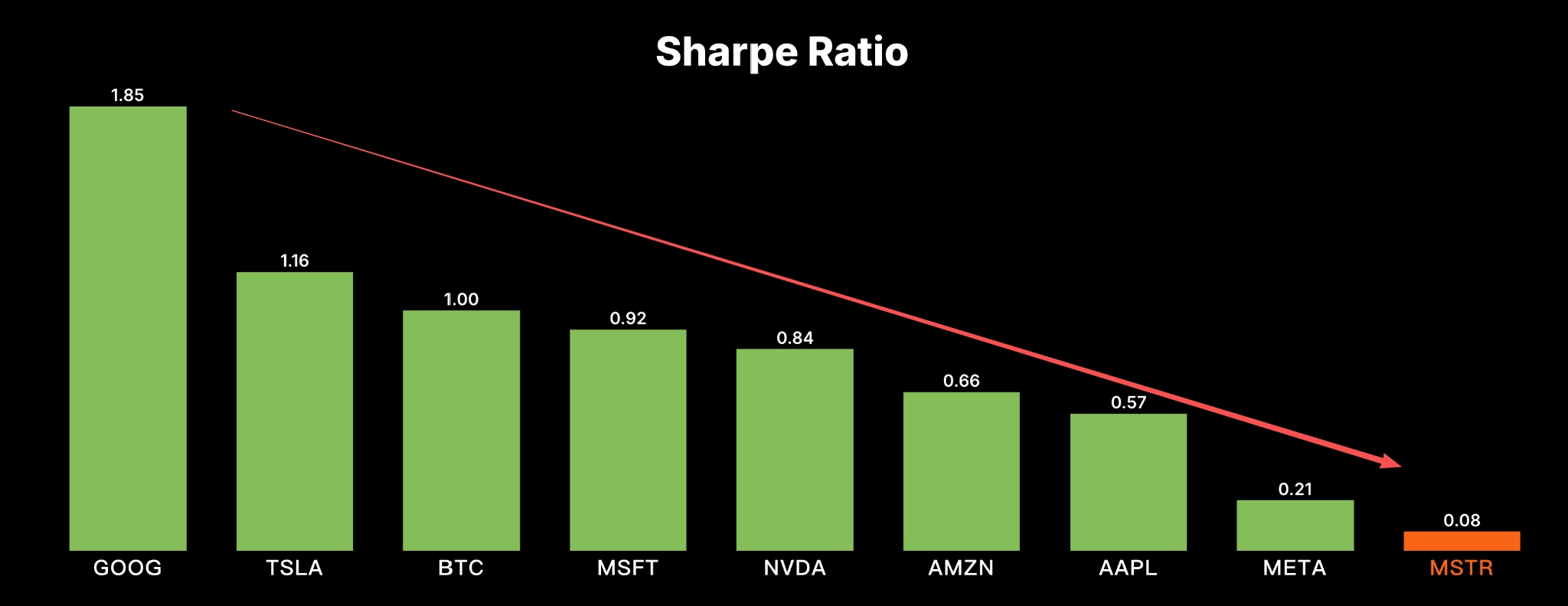
【MicroStrategy's May and November Sharpe Ratios】
Note: The Sharpe ratio in finance measures an investment's performance, adjusted for its risk, relative to a risk-free asset. It is defined as the expected difference between the investment's return and the risk-free return, divided by the investment's standard deviation (i.e., its volatility). It represents the extra return an investor receives for each unit of additional risk taken.
We observe that MicroStrategy's Sharpe ratio has dropped from 1.59 to 0.08 within six months, indicating extremely high uncertainty in its stock price.

【MicroStrategy's mNAV (Diluted), Source: StrategyTracker】
Note: mNAV is the ratio of market capitalization to the total value of held Bitcoin.
According to StrategyTracker data, MicroStrategy's mNAV has reached 1.11. If the mNAV value falls below 1, it implies that purchasing the company's stock is no longer more valuable than directly purchasing Bitcoin.
Currently, MicroStrategy's high valuation and lack of fundamental support make it a high-risk investment. Historically high returns do not guarantee their continuation, and MicroStrategy's future remains highly uncertain. If Bitcoin fails to maintain its strength in 2026, and MicroStrategy continues to acquire Bitcoin without repurchasing its own shares, its market capitalization will likely continue to decline, and the mNAV may trigger an alarm.
We advise caution with this stock unless investors possess extremely high risk tolerance and can accept significant price volatility.



